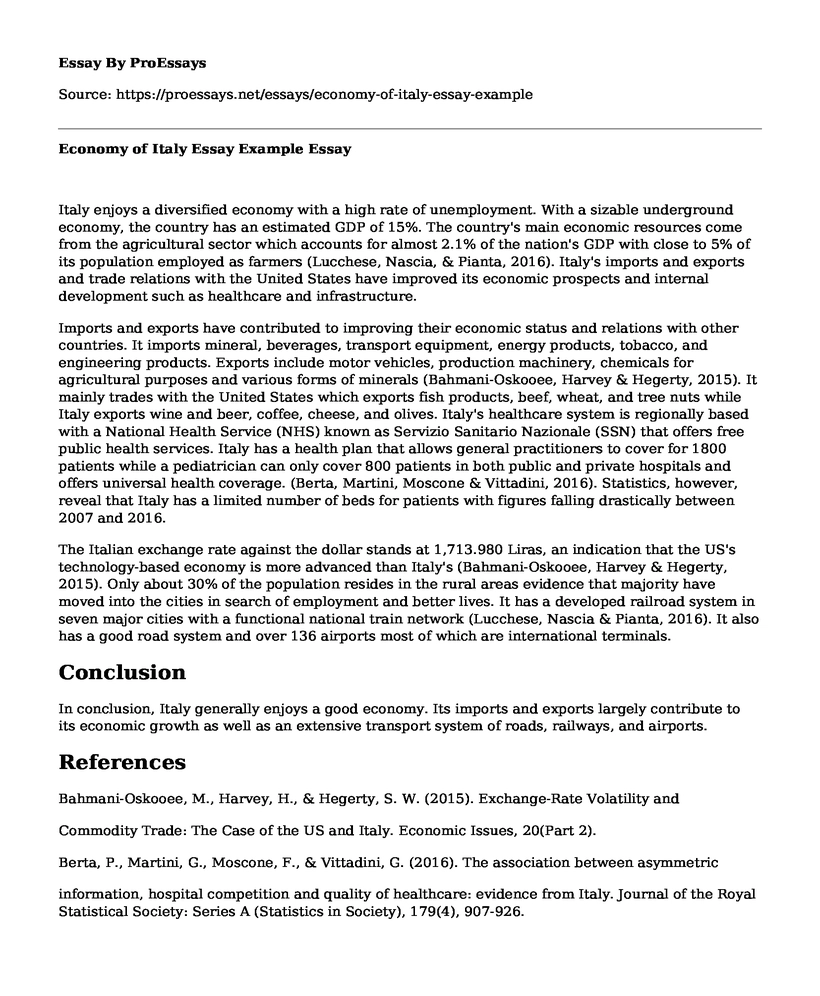Italy enjoys a diversified economy with a high rate of unemployment. With a sizable underground economy, the country has an estimated GDP of 15%. The country's main economic resources come from the agricultural sector which accounts for almost 2.1% of the nation's GDP with close to 5% of its population employed as farmers (Lucchese, Nascia, & Pianta, 2016). Italy's imports and exports and trade relations with the United States have improved its economic prospects and internal development such as healthcare and infrastructure.
Imports and exports have contributed to improving their economic status and relations with other countries. It imports mineral, beverages, transport equipment, energy products, tobacco, and engineering products. Exports include motor vehicles, production machinery, chemicals for agricultural purposes and various forms of minerals (Bahmani-Oskooee, Harvey & Hegerty, 2015). It mainly trades with the United States which exports fish products, beef, wheat, and tree nuts while Italy exports wine and beer, coffee, cheese, and olives. Italy's healthcare system is regionally based with a National Health Service (NHS) known as Servizio Sanitario Nazionale (SSN) that offers free public health services. Italy has a health plan that allows general practitioners to cover for 1800 patients while a pediatrician can only cover 800 patients in both public and private hospitals and offers universal health coverage. (Berta, Martini, Moscone & Vittadini, 2016). Statistics, however, reveal that Italy has a limited number of beds for patients with figures falling drastically between 2007 and 2016.
The Italian exchange rate against the dollar stands at 1,713.980 Liras, an indication that the US's technology-based economy is more advanced than Italy's (Bahmani-Oskooee, Harvey & Hegerty, 2015). Only about 30% of the population resides in the rural areas evidence that majority have moved into the cities in search of employment and better lives. It has a developed railroad system in seven major cities with a functional national train network (Lucchese, Nascia & Pianta, 2016). It also has a good road system and over 136 airports most of which are international terminals.
Conclusion
In conclusion, Italy generally enjoys a good economy. Its imports and exports largely contribute to its economic growth as well as an extensive transport system of roads, railways, and airports.
References
Bahmani-Oskooee, M., Harvey, H., & Hegerty, S. W. (2015). Exchange-Rate Volatility and
Commodity Trade: The Case of the US and Italy. Economic Issues, 20(Part 2).
Berta, P., Martini, G., Moscone, F., & Vittadini, G. (2016). The association between asymmetric
information, hospital competition and quality of healthcare: evidence from Italy. Journal of the Royal Statistical Society: Series A (Statistics in Society), 179(4), 907-926.
Lucchese, M., Nascia, L., & Pianta, M. (2016). Industrial policy and technology in Italy. Economia e politica industriale, 43(3), 233-260.
Cite this page
Economy of Italy Essay Example. (2022, Nov 15). Retrieved from https://proessays.net/essays/economy-of-italy-essay-example
If you are the original author of this essay and no longer wish to have it published on the ProEssays website, please click below to request its removal:
- NAFTA Trade Agreement Essay Example
- Unemployment and Inflation Rate in the UK Essay
- Essay Sample on Termination Process
- Essay Example on Evolving Labor Movements: Protecting Worker Rights in the U.S.
- Essay Example on US Flu Surveillance Data Unreliable: Estimates Used Instead of Cases
- Essay on Exploring Imperialism, Sex, and Science: Author's Purpose in Book on U.S. Policy in Puerto Rico
- Eating While Endless Essay Example







